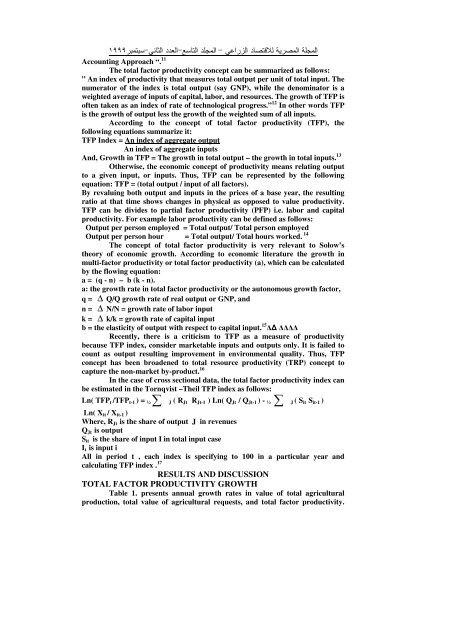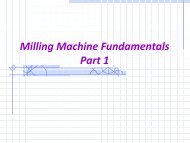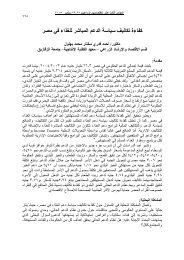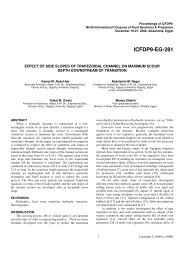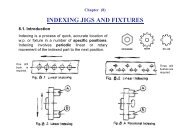Total Factor Productivity and Sources of Long-Term Growth in ...
Total Factor Productivity and Sources of Long-Term Growth in ...
Total Factor Productivity and Sources of Long-Term Growth in ...
Create successful ePaper yourself
Turn your PDF publications into a flip-book with our unique Google optimized e-Paper software.
- - - <br />
Account<strong>in</strong>g Approach “. 11<br />
The total factor productivity concept can be summarized as follows:<br />
” An <strong>in</strong>dex <strong>of</strong> productivity that measures total output per unit <strong>of</strong> total <strong>in</strong>put. The<br />
numerator <strong>of</strong> the <strong>in</strong>dex is total output (say GNP), while the denom<strong>in</strong>ator is a<br />
weighted average <strong>of</strong> <strong>in</strong>puts <strong>of</strong> capital, labor, <strong>and</strong> resources. The growth <strong>of</strong> TFP is<br />
<strong>of</strong>ten taken as an <strong>in</strong>dex <strong>of</strong> rate <strong>of</strong> technological progress.” 12 In other words TFP<br />
is the growth <strong>of</strong> output less the growth <strong>of</strong> the weighted sum <strong>of</strong> all <strong>in</strong>puts.<br />
Accord<strong>in</strong>g to the concept <strong>of</strong> total factor productivity (TFP), the<br />
follow<strong>in</strong>g equations summarize it:<br />
TFP Index = An <strong>in</strong>dex <strong>of</strong> aggregate output<br />
An <strong>in</strong>dex <strong>of</strong> aggregate <strong>in</strong>puts<br />
And, <strong>Growth</strong> <strong>in</strong> TFP = The growth <strong>in</strong> total output – the growth <strong>in</strong> total <strong>in</strong>puts. 13<br />
Otherwise, the economic concept <strong>of</strong> productivity means relat<strong>in</strong>g output<br />
to a given <strong>in</strong>put, or <strong>in</strong>puts. Thus, TFP can be represented by the follow<strong>in</strong>g<br />
equation: TFP = (total output / <strong>in</strong>put <strong>of</strong> all factors).<br />
By revalu<strong>in</strong>g both output <strong>and</strong> <strong>in</strong>puts <strong>in</strong> the prices <strong>of</strong> a base year, the result<strong>in</strong>g<br />
ratio at that time shows changes <strong>in</strong> physical as opposed to value productivity.<br />
TFP can be divides to partial factor productivity (PFP) i.e. labor <strong>and</strong> capital<br />
productivity. For example labor productivity can be def<strong>in</strong>ed as follows:<br />
Output per person employed = <strong>Total</strong> output/ <strong>Total</strong> person employed<br />
Output per person hour = <strong>Total</strong> output/ <strong>Total</strong> hours worked. 14<br />
The concept <strong>of</strong> total factor productivity is very relevant to Solow’s<br />
theory <strong>of</strong> economic growth. Accord<strong>in</strong>g to economic literature the growth <strong>in</strong><br />
multi-factor productivity or total factor productivity (a), which can be calculated<br />
by the flow<strong>in</strong>g equation:<br />
a = (q - n) – b (k - n).<br />
a: the growth rate <strong>in</strong> total factor productivity or the autonomous growth factor,<br />
q = ∆ Q/Q growth rate <strong>of</strong> real output or GNP, <strong>and</strong><br />
n = ∆ N/N = growth rate <strong>of</strong> labor <strong>in</strong>put<br />
k = ∆ k/k = growth rate <strong>of</strong> capital <strong>in</strong>put<br />
b = the elasticity <strong>of</strong> output with respect to capital <strong>in</strong>put. 15 ∆∆ ∆∆∆∆<br />
Recently, there is a criticism to TFP as a measure <strong>of</strong> productivity<br />
because TFP <strong>in</strong>dex, consider marketable <strong>in</strong>puts <strong>and</strong> outputs only. It is failed to<br />
count as output result<strong>in</strong>g improvement <strong>in</strong> environmental quality. Thus, TFP<br />
concept has been broadened to total resource productivity (TRP) concept to<br />
capture the non-market by-product. 16<br />
In the case <strong>of</strong> cross sectional data, the total factor productivity <strong>in</strong>dex can<br />
be estimated <strong>in</strong> the Tornqvist –Theil TFP <strong>in</strong>dex as follows:<br />
Ln( TFP t /TFP t-1 ) = ½ ∑ J ( R Jt R Jt-1 ) Ln( Q Jt / Q Jt-1 ) - ½ ∑ J ( S it S it-1 )<br />
Ln( X it / X it-1 )<br />
Where, R Jt is the share <strong>of</strong> output J <strong>in</strong> revenues<br />
Q Jt is output<br />
S it is the share <strong>of</strong> <strong>in</strong>put I <strong>in</strong> total <strong>in</strong>put case<br />
I t is <strong>in</strong>put i<br />
All <strong>in</strong> period t , each <strong>in</strong>dex is specify<strong>in</strong>g to 100 <strong>in</strong> a particular year <strong>and</strong><br />
calculat<strong>in</strong>g TFP <strong>in</strong>dex . 17 RESULTS AND DISCUSSION<br />
TOTAL FACTOR PRODUCTIVITY GROWTH<br />
Table 1. presents annual growth rates <strong>in</strong> value <strong>of</strong> total agricultural<br />
production, total value <strong>of</strong> agricultural requests, <strong>and</strong> total factor productivity.


